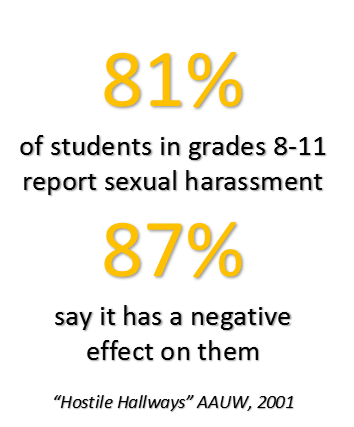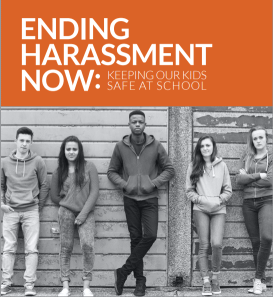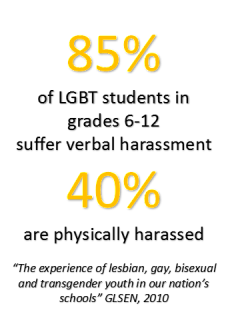 Students are sexually harassed in school every day. It’s likely happening in schools in your community. It begins in elementary schools and occurs with alarming frequency in middle and high schools. The victims are girls, boys, and gender non-conforming students. It’s a form of discrimination and it’s against federal law under Title IX.
Students are sexually harassed in school every day. It’s likely happening in schools in your community. It begins in elementary schools and occurs with alarming frequency in middle and high schools. The victims are girls, boys, and gender non-conforming students. It’s a form of discrimination and it’s against federal law under Title IX.
Do you know your rights at school under Title IX?
Title IX has been law for over 50 years. School administrators ignore it at their peril. The U.S. Department of Education Office for Civil Rights (OCR) reports that sexual violence complaints filed against elementary and secondary schools increased by 208 percent between FY 2010 and FY 2019. An increasing number of school districts face OCR investigations.
More Title IX lawsuits are being filed in federal courts. More families are successfully suing districts over mishandling sexual harassment and violence, and reaching large monetary settlements. And more media reports cast ill-informed school districts across the country in an unfavorable light.
Equal Rights Advocates has excellent guides on Gender Discrimination and Sexual Harassment and Assault.
What schools get wrong
School districts often believe they can inoculate themselves against legal action and bad press by simply denying or ignoring sexual harassment and assault in their schools. They can devise elaborate strategies to deflect liability for their failure to protect students from harassment and assault. Their “report card” contains straight Ds: Delay (investigating), Deny (responsibility), Distort (the facts), Disparage (the victim), and Devalue (the victim’s right to an equal education). They admit to victim-blaming as a tactic to mitigate liability. Denying or ignoring sexual harassment is always the wrong course of action because school districts end up harming the very students they are mandated to serve.
 Although school staff claim to take sexual harassment and violence seriously, as evidenced, they say, by their written anti-harassment policies, too often they are unprepared to respond appropriately to real incidents. School administrators are woefully ignorant of their Title IX responsibilities.
Although school staff claim to take sexual harassment and violence seriously, as evidenced, they say, by their written anti-harassment policies, too often they are unprepared to respond appropriately to real incidents. School administrators are woefully ignorant of their Title IX responsibilities.
Ignorance, the fear of liability, and concerns about public opinion cause schools to downplay, ignore, or deny altogether reports of sexual harassment/assault and subsequent retaliation against victims.
School administrators then rationalize their failure to address sexual harassment and assault by explicitly or tacitly sanctioning these fallacies:
 Sexual assault and harassment rarely occurs among school age children. Wrong. A large majority of students experience some form of sexual harassment during their middle and high school years. Almost all of them feel that the sexual harassment has a negative effect. Lesbian, gay, bisexual, and transgender students routinely report being physically and verbally harassed because of their sexual orientation.
Sexual assault and harassment rarely occurs among school age children. Wrong. A large majority of students experience some form of sexual harassment during their middle and high school years. Almost all of them feel that the sexual harassment has a negative effect. Lesbian, gay, bisexual, and transgender students routinely report being physically and verbally harassed because of their sexual orientation. ![]()
It’s just kids being kids, so it’s hard to enforce anti-harassment policies. This attitude actually promotes sex discrimination. It reinforces stereotypical messages about sexuality to both boys and girls, and encourages unhealthy, destructive sexual expression. Parents do not send their children to school to be sexually harmed or victimized. Kids cannot learn in a hostile school environment. Schools have an obligation to ensure the safety of all students with whom they have been entrusted. A persistent, sexually hostile school environment is diagnostic of irresponsibility and failure on the part of teachers, counselors, administrators, and district leadership.
Students have to learn to get over it. Sex-based harassment causes real emotional, psychological, and economic damage to students. Feeling unsafe at school correlates with declining academic performance, skipping school, and dropping out. Girls and young women who drop out of school due to sexual or gender-based harassment can have higher rates of unemployment than men who drop out. Those who do get jobs make significantly lower wages than male dropouts. Some students never “get over it;” they take their own lives.
Not only does OCR require schools to address sexual harassment/violence promptly and effectively, and to prevent recurrence, it also expects school districts to train staff proactively about how to respond appropriately to sex discrimination, including harassment and violence.
Our website resources are designed to enable communities to ensure school districts respond properly to sexual harassment and violence in ways that comply with OCR guidance on Title IX. Schools that are unprepared to act responsibly in accordance with federal anti-discrimination laws suffer painful regulatory and financial consequences, bad press, a loss of public support, while failing to provide their students with a healthy educational environment.
